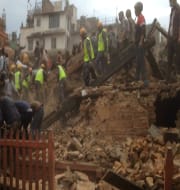7.8 magnitude earthquake struck Nepal
A high-intensity earthquake of magnitude 7.8 on the Richter scale had struck central Nepal between its capital Kathmandu and the city of Pokhara on 25 April 2015.
Earthquake’s epicenter was 80 kilometers east of Pokhra near Kathmandu. It had a depth of only 11 kilometers (7 miles) i.e. in geological terms it was a shallow depth.
The intensity of this earthquake was high due to its shallower depth which had more destructive power. It has resulted in thousands of deaths and tremendous loss of property.
The tremors of this quake were felt in north Indian states of Bihar, Jharkhand, Uttar Pradesh, Rajasthan, Assam, Delhi, Madhya Pradesh, West Bengal, Haryana, and Punjab. The tremors were also reported in Pakistan and Bangladesh.
Earlier, Nepal had suffered its worst recorded earthquake in 1934. It was measured 8.0 and had destroyed the cities of Kathmandu, Bhaktapur and Patan.
Reasons for catastrophic earthquake in Nepal
- This earthquake in Nepal may have occurred because of two converging tectonic plates, the India plate and the overriding Eurasian plate.
- These tectonic plates are the large, thin, relatively rigid and are moving relative to one another on the outer surface of the Earth. Both of these plates are slowly moving and sometimes get stuck at their edges due to friction.
- Earthquake might have occured because of these overriding plates after the stress on the edge overcomes the friction. It releases tremendous energy in form of waves that travel through the Earth’s crust and causes earthquake on the surface.
Month: Current Affairs - April, 2015


